Becoming a freelancer is a lucrative career path for many, but it can also be a daunting one. Knowing how and where to start is a challenge for many. Whether you’re used to the 9-5 life or entering the job market for the first time. That’s why I’ve put together this step-by-step guide on how to become a freelancer.
I’ve been a freelancer since 2019, so I’ll draw on my own experience having started while I was still studying at university.
Let’s get straight into it!
1. Find Your Niche
Your niche is your specialization, your area of expertise. It’s where you excel and where your passion lies—at least it should be.
To identify your niche, ask yourself what you’re genuinely passionate about and what skills you possess that can address a specific need in the market.
Are you a talented graphic designer, a skilled writer, or a proficient web developer?
The narrower your niche, the easier it is to become an expert and attract clients seeking your specific skills.
Beware Of Being A Generalist
If you haven’t found your niche, you can market yourself as a generalist instead. But beware, there are lots of generalist freelancers out there. This is common in the writing industry, where I first started freelancing on Fiverr.
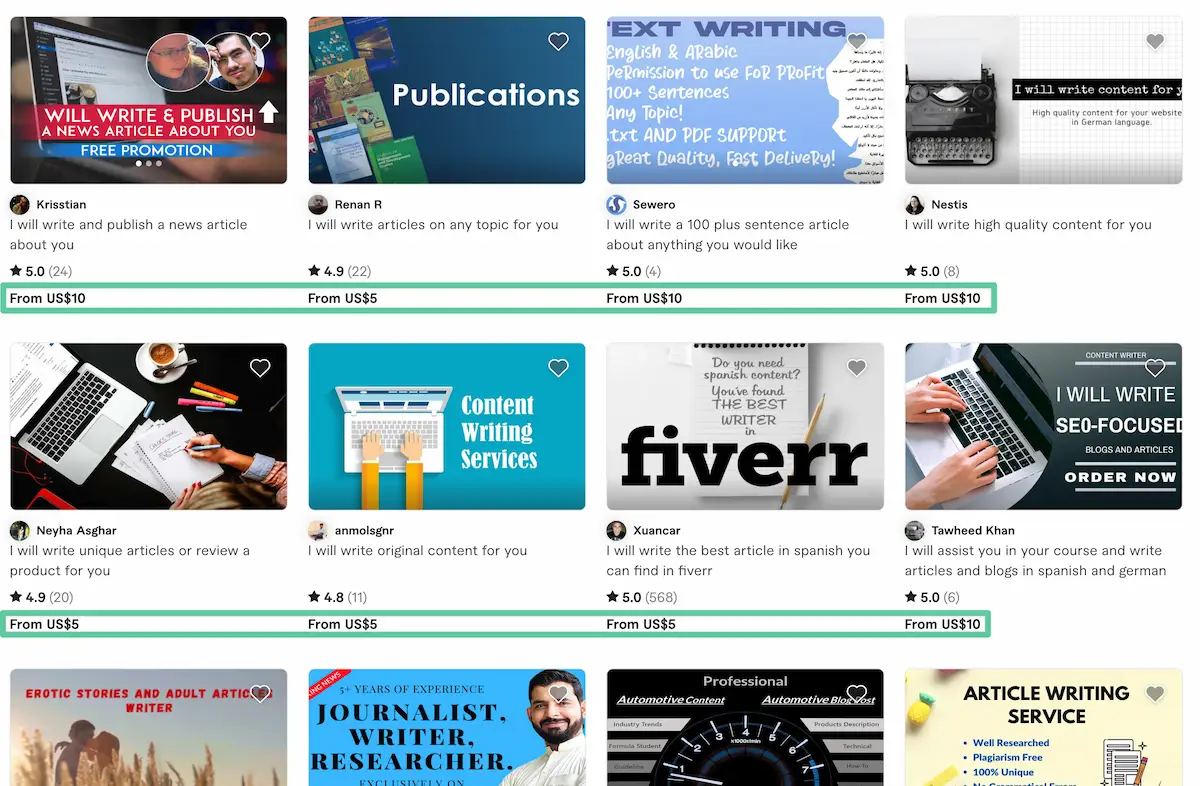
I’d be sitting in uni lectures writing content for buyers on Fiverr on all kinds of topics. From ecommerce stores selling furniture to blog posts on finance websites. It helped me get my start, but the pay was low and it was ultra competitive (see screenshot above).
I’m still grateful for that time, but within a year I’d moved on to more niche-specific writing. Not only did it pay more, but it was also far more enjoyable as I could really immerse myself in the niches.
This goes for freelancing roles beyond writing too. If you’re looking to become a freelance graphic designer, consider niching down to designing graphics for marketing campaigns. Or logos for small businesses.
If you want to become a freelance developer, maybe you could niche down to building websites for businesses. Or focus on app development.
2. Establish Your Skills
Now that you’ve identified your niche, it’s time to build and strengthen your skills. Your freelancing success hinges on your ability to deliver high-quality work consistently.
Ideally, the niche you pick will be one in which you already have skills. Sure, enjoying writing might make freelancing in that industry a viable career. But you also need to be a good writer!
Investing in your skills is a continuous process though. So you don’t necessarily need to be a master of the skill to get your first clients. There are lots of ways to pick up new skills and knowledge (beyond learning on the job).
Common ways to learn freelancing skills include:
- YouTube videos (super useful and free)
- Courses (on websites like Udemy or Coursera)
- Industry blogs (like this one!)
- Following experts on social media
- Having discussions in forums
I specialize in search engine optimization (SEO), and I devote time each day to continuously learning and improving upon my skills and knowledge (spoiler: that’s also Step 8 on this list).
This can involve learning from others through courses and other resources, but also by following people in the industry on social media. This creates a sort of “passive learning” process, so I’m always picking up new things even just scrolling through my social media feeds!
3. Define Your Target Market
Your niche is a starting point, but you must also identify the specific audience that needs your services.
Research your potential clients thoroughly, answering questions like:
- Who are they?
- What are their pain points, challenges, and preferences?
- Do they really need your services?
- What industries do they operate in?
- What are their budgets like?
Knowing your target market allows you to tailor your services, marketing efforts, and communication to meet their needs effectively. But it also shows you whether there really is a big enough market.
As you define your target market, consider creating buyer personas. These are detailed profiles that represent your ideal clients.
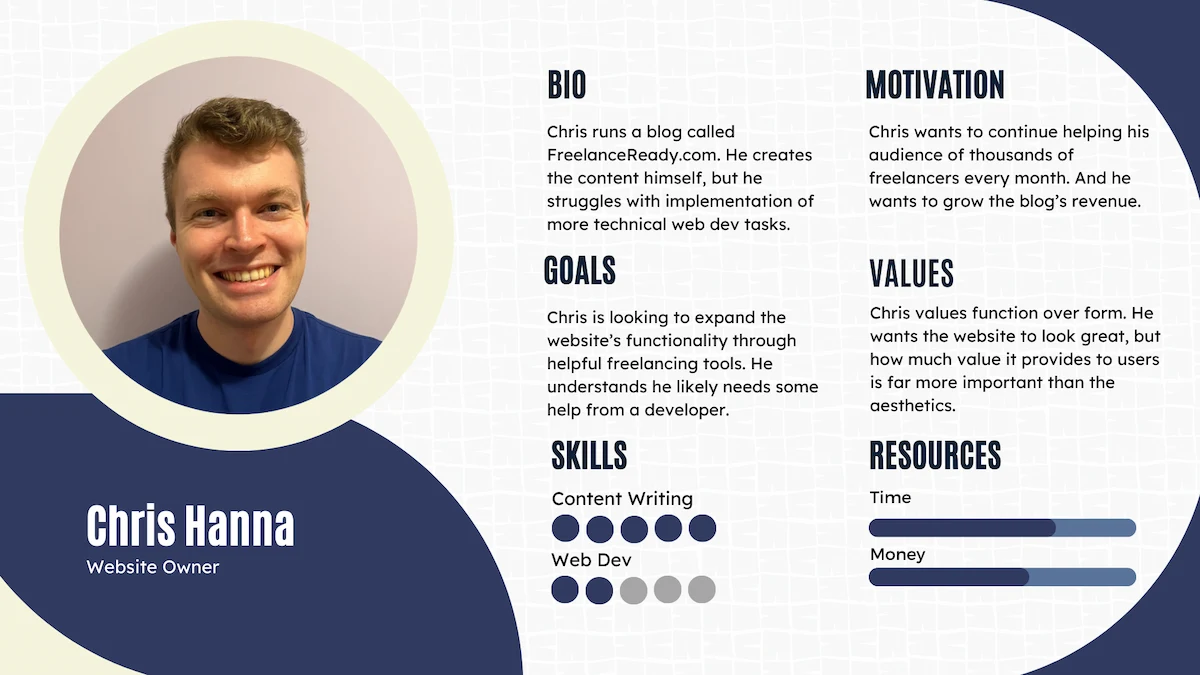
You can go the extra mile and actually create imaginary profiles, but the key things to consider are:
- Are they individuals or business owners?
- What industry are they in?
- Where are they located (if relevant)?
- Are they big spenders or will they likely be on a budget? (This will obviously affect your pricing potential)
- What specific problems do they face?
- What specific solutions can you offer?
4. Build Your Portfolio
Creating a compelling portfolio involves showcasing your best work and presenting it in an organized and visually appealing manner. Whether you’re a writer, graphic designer, business consultant, or web developer—you need a portfolio.
Start by selecting a diverse range of projects that showcase your versatility within your chosen niche. Each portfolio piece should include a brief description explaining the project’s context, your role, and the results you achieved.
High-quality visuals (like images, screenshots, or video demos) can help bring your work to life (if relevant, as writing samples likely won’t benefit from a video, for example).
How To Create A Freelancing Portfolio
There are lots of ways to make one, with the most obvious but highest-effort being to build your own website. You can do this fairly easily nowadays with the likes of WordPress and the many other website builders out there.
But there are also platforms like Medium that are great for freelance writers, and dedicated portfolio platforms like Contently.
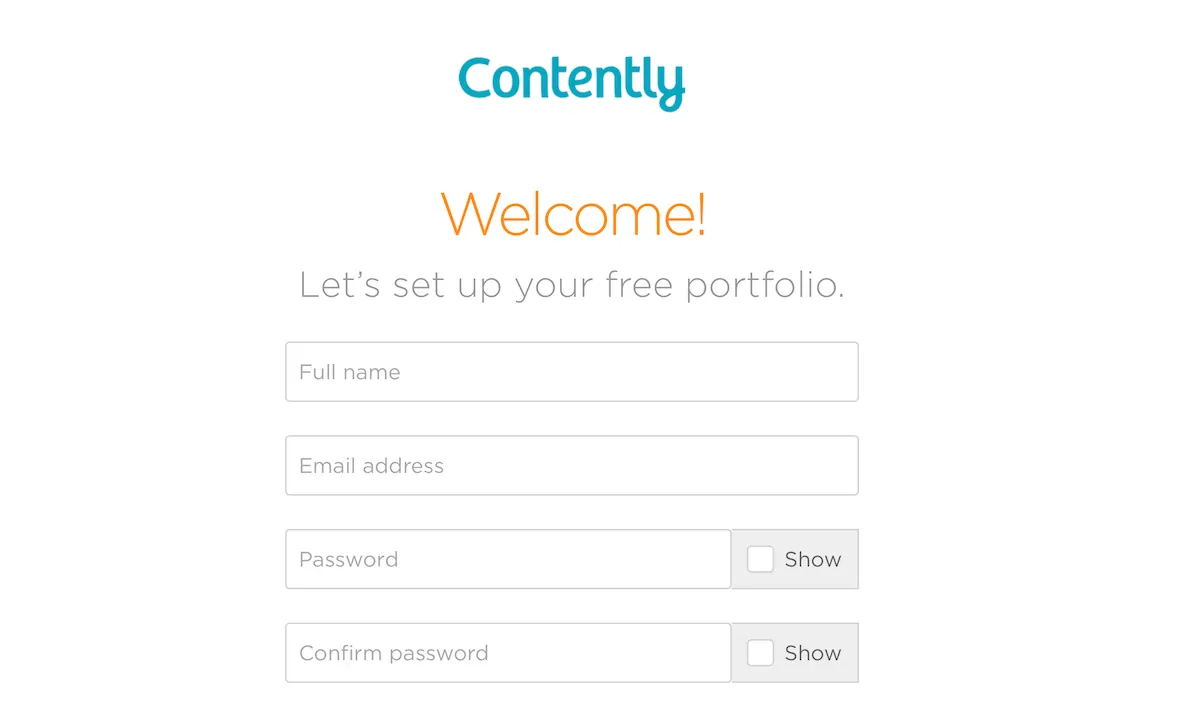
Pro Tip: Regularly update your portfolio as you complete new projects or achieve milestones in your career.
If you don’t have any samples—which is likely if you’ve never had a paying client before—create some of your own!
Create mock websites if you’re a web developer, or write some blog posts if you’re a writer. Create some logos for imaginary businesses if you want to sell graphic design services.
Not having any experience doesn’t mean you can’t show off your skills (more on that later).
5. Set Your Freelancing Rates
Your freelancing rates should reflect the value you provide while remaining competitive within your niche. Start by researching industry standards and analyzing what other freelancers with similar skills and experience charge. This research can provide a baseline for setting your rates.
Consider asking in forums or communities to get answers from people in similar situations with the same kind of experience.
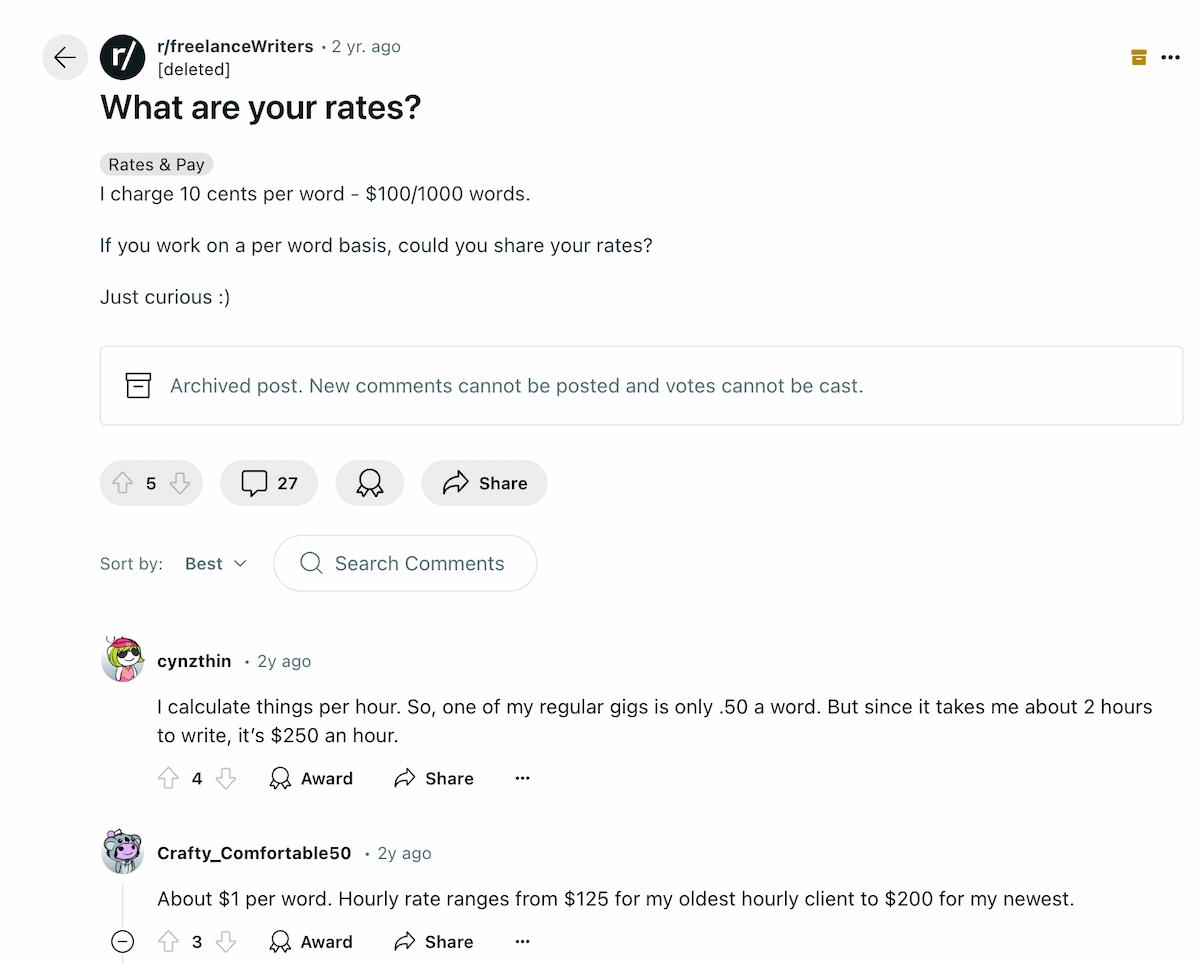
When setting your prices, consider your financial goals, cost of living, and freelance business expenses. You might choose to charge hourly or per project, or based on the value you bring to the client. Or per word if you’re a freelance writer.
Remember that your rates can and should evolve as your skills and experience grow. Don’t be afraid to adjust them accordingly to reflect your increasing expertise and the demand for your services.
My Experience
A cautionary tale: don’t set your prices too low!
As I mentioned at the start of the article, I got my first few freelancing clients on Fiverr. It’s a freelance marketplace, and while it can be a great place to start as a beginner freelancer, it’s very competitive and notorious for being home to many cheap freelance services.
Back when I first started, I was one of those cheap freelancers. My first job on the platform—a writing gig—made me a whopping $2 per hour!
Sustainable? No chance!
Necessary? Probably not.
Regrettable? Somewhat.
I felt I had to charge low prices if I wanted to get any clients without much of a reputation behind me. Maybe I did, but I imagine if I had raised my prices to be at least a little closer to minimum wage and persevered, I would have gotten some clients under my belt.
Thankfully I didn’t have to work at these rates for long. But it did take a while to get above $10 per hour for my writing. I was also working part-time in a local shop, so I had some extra income anyway.
But eventually, I racked up 100+ five-star reviews with some high-paying clients along the way, before I gradually moved away from the platform to external clients.
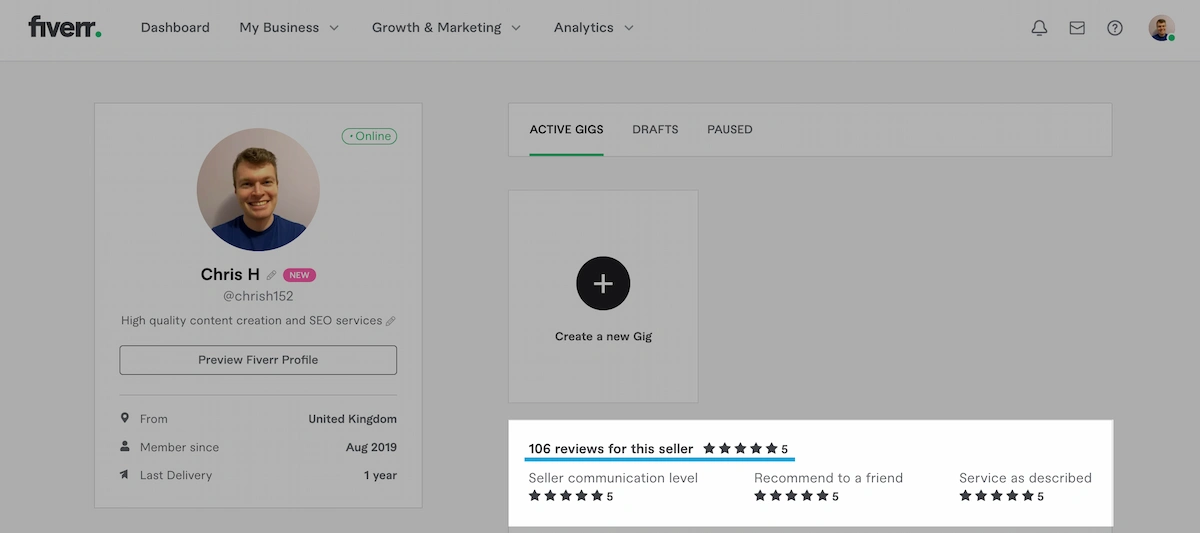
So, if you’re diving into freelancing with no other income sources, really take some time to consider your rates to ensure you don’t price your services in a way that’s not sustainable.
6. Get Your First Clients
Securing your first freelancing clients can be a daunting task. But it’s a must if you want to get anywhere with it! Thankfully, everyone has to start somewhere. So you can go in knowing that it is possible. It’s just going to take some work.
Start by tapping into your existing network. Let friends, family, and any professional contacts know about your freelance services. Personal recommendations and word of mouth can be super powerful for landing your first clients.
But realistically, many of you (like me) will need to look elsewhere to find your first clients. Enter: freelance marketplaces and job boards.
Online freelancing platforms like Upwork, Fiverr, and Freelancer.com connect freelancers with clients seeking specific services.

To find success on these platforms, create a compelling profile that highlights your skills, experience, and portfolio (see Step 4). Be proactive in applying for relevant projects and building a reputation for delivering quality work.
There are also niche-specific job boards out there, and I’ve listed a few of them below:
- ProBlogger for writers (and freelance editors)
- 99designs for creative freelancers
- Toptal for technical freelancers (this one is tougher to get into)
7. Build Out Your Network
Building a strong professional network is an ongoing process that can really help you build a sustainable freelancing career. Join online forums, social media groups, and communities related to your niche.
Engage in conversations, share your insights, and seek opportunities to collaborate with others in your field. You don’t need to post every day. But being active on these platforms is an easy way to show off your experience.
Networking isn’t just about finding clients. It’s also about connecting with peers who can provide support and mentorship. Don’t hesitate to reach out to experienced freelancers for advice and guidance. Building a network of mentors and peers can provide valuable insights and help you navigate the ups and downs of freelancing.
8. Keep Learning And Improving
To stay competitive and relevant in your industry, you need to embrace lifelong learning (something I believe is key in all aspects of life, not just freelancing). Dedicate time to expanding your skills and staying updated on industry developments.
Continuous improvement benefits your clients and also keeps your work fresh and exciting. As I mentioned earlier, formal learning doesn’t need to be the only way. You can also learn from others on social media, YouTube, and other more informal spaces.
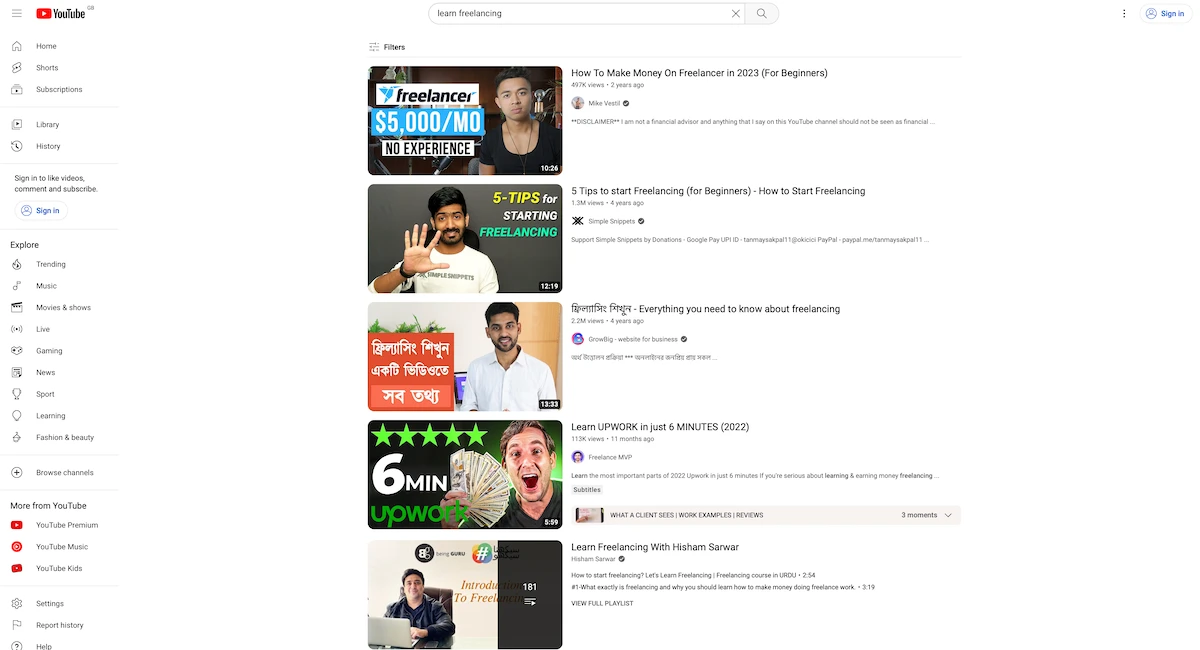
From a more direct perspective, you also need to take feedback from clients and peers to identify areas you need to improve.
Embrace constructive criticism as an opportunity to grow and refine your skills (and try not to take it personally). A commitment to learning and improvement will help you retain clients. And it’ll also make it easier to attract new ones seeking the best freelancers in the field.
The Pros & Cons Of Becoming A Freelancer
| Pros of Freelancing | Cons of Freelancing |
|---|---|
| Flexibility | Income variability |
| Diverse client base | Lack of job security |
| Autonomy | No employee benefits |
| High income potential | Isolation |
| Location independence | More administrative tasks |
The Pros
Flexibility: Freelancers have the freedom to set their own schedules and work from anywhere, providing a better work-life balance. This is one of the major draws for beginners.
Diverse Client Base: Freelancers can work with a variety of clients, gaining exposure to different industries and projects.
Autonomy: Freelancers have control over their projects, allowing them to choose the type of work they are passionate about. Of course, you’re still going to need to work within a set of guidelines and deadlines from clients.
Income Potential: Successful freelancers can earn a higher income than they might in a traditional job, especially if they specialize in a high-demand niche (but you need to take things into account like expenses and potentially higher taxes).
Location Independence: Freelancers are not tied to a specific location and can work from anywhere in the world, opening up opportunities for travel and exploration. There are obviously exceptions to this if you offer physical services rather than being a digital freelancer.
Note: If you do offer physical services, consider using a marketplace like Taskrabbit to find jobs. See how the platform holds up in our comparison of Fiverr and Taskrabbit.
The Cons
Income Variability: Freelancers often face irregular income, with no guarantee of steady paychecks or benefits. I’ve personally gone through multiple spells of several months with no substantial income (which makes managing your money vital).
Lack of Job Security: Freelancers may experience periods of unemployment or difficulty finding clients, leading to financial instability. This can take its toll on your mental state, as you need to be able to stay focused and motivated when things aren’t going to plan.
No Employee Benefits: Freelancers are responsible for their own health insurance, retirement planning, and other benefits that traditional employers typically provide.
Isolation: Freelancers often work alone, which can lead to feelings of loneliness and isolation. This suits many people and, like the flexibility aspect, is what actually makes a lot of people want to start freelancing in the first place.
Administrative Tasks: Freelancers must handle administrative tasks like invoicing, taxes, and client management, which can be time-consuming and complex. There are invoicing apps out there, but it can be intimidating at first.
How To Start Freelancing With No Experience
To start freelancing without any experience, begin by taking stock of your skills, interests, and passions. Consider what you enjoy doing and where your talents lie. While you may not have direct professional experience, you likely have transferable skills that can be valuable in the freelancing world.
These skills could include:
- Writing
- Graphic design
- Social media management
- Customer service
- Data entry
Identifying your strengths will help you determine the services you can offer to potential clients.
Once you’ve pinpointed your skills, it’s time to enhance and expand them. There are plenty of online resources and courses out there, many of which are free or at least fairly affordable. Platforms like Coursera and Udemy offer a wide range of courses that can help you acquire new skills or deepen your existing ones.
But again, even just checking out YouTube videos on the subject can teach you a lot of the fundamentals.
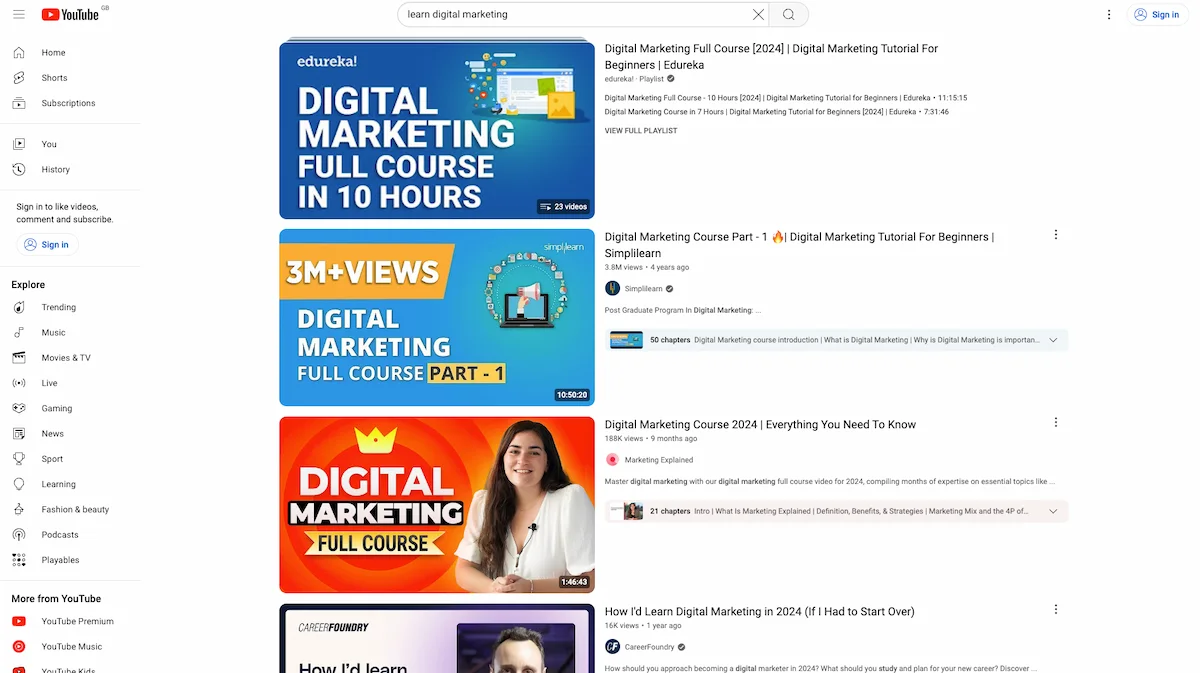
Your Portfolio Is Key
Although you may not have professional experience, you can still build a portfolio to showcase your abilities—in fact it’s a must.
Create sample projects or offer your services to friends or family at a reduced rate (or even for free) in exchange for testimonials and work samples. These early projects can help demonstrate your competence to potential clients.
Note: Offering a piece of work for free might help you get a testimonial or sample. But this is not sustainable, so don’t make it a regular thing.
The next step is to bolster your online presence by ensuring you appear in all the right places. Set up a professional social media profile, such as LinkedIn, and create profiles on other relevant platforms.
Do You Need Experience To Become A Freelancer?
You don’t need experience to become a freelancer. At least you don’t need freelancing experience. You will obviously need some sort of experience with the skill or niche you want to specialize in. If you don’t have any experience writing for example, it’s unlikely that you’ll make a good freelance writer (or want to become one in the first place).
But “experience” can often be misunderstood in this context. If you did a lot of great writing in school or university, then you might indeed be able to offer that as a service.
If you don’t have any formal experience as a graphic designer, but you love playing around with Adobe Illustrator or Canva, then maybe you could offer logo design services to businesses.
It’s not as clear-cut as you need a specific type or amount of experience to make it as a freelancer. Instead, it’s all about how well you can market the experience you do have.
Should You Start Freelancing?
Going down the path of becoming a freelancer is something that many people will take in their stride. While others really struggle to adapt to the fast-paced and high-intensity environment. Whether or not it’s right for you will depend on a lot of different factors.
You need to consider whether you enjoy working under pressure and to your own deadlines and schedules. For some it sounds like a dream, but the reality is that it takes a lot of hard work and perseverance. For more on this, check out our article on the downsides of freelancing.
If you are struggling to choose between career options, check out my guide to freelancing vs traditional employment.
Freelance Ready is reader-supported. That means some links on this website are affiliate links. If you sign up or make a purchase through these links, we may earn a commission.

